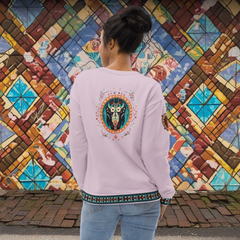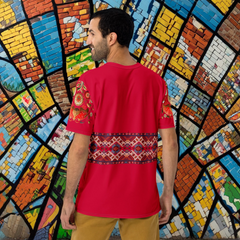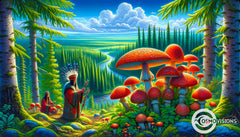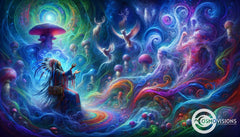Fly Agaric and the Path to the Spirit World: Inside the Koryak People’s Sacred Mushroom Rituals
Posted by Massimiliano Geraci
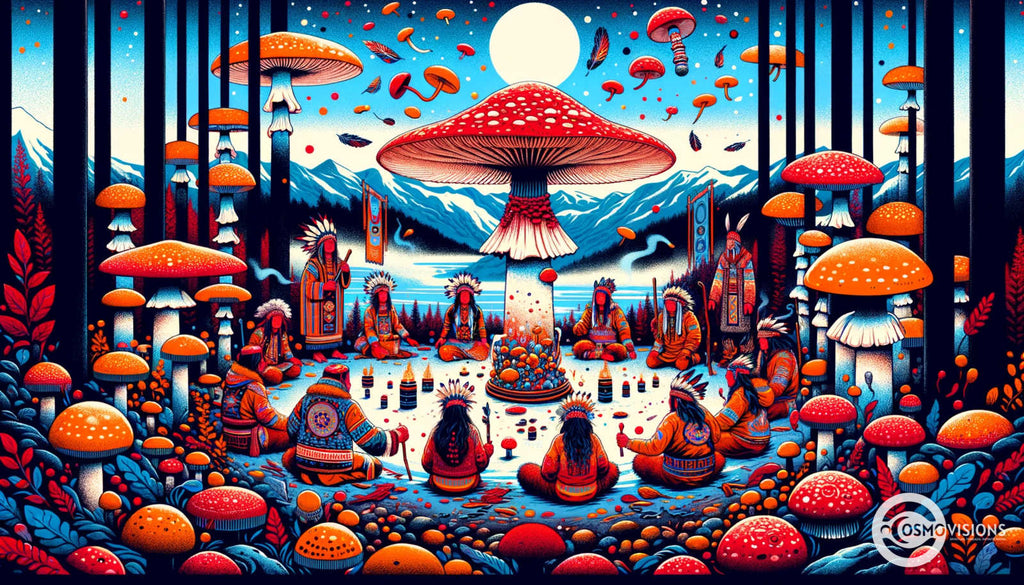
Tucked into the farthest reaches of the remote Kamchatka Peninsula, an ethnic group known as the Koryak people have developed an intricate, generations-old relationship with the fly agaric mushroom, Amanita muscaria. This vivid red fungi with white flecks has become deeply interwoven into Koryak cosmology, shamanic rituals, mythology, folklore and rites of passage.
For the nomadic reindeer-herding inland Koryak and the maritime seal-hunting coastal Koryak, Amanita muscaria facilitates a direct pathway into the realm of spirits, ancestors and animal guides. Ritual specialist шаманы (shamans) harness the mushroom’s psychedelic effects to journey across worlds, gaining wisdom to heal their communities.
The Koryak’s reverence for the fly agaric mushroom provides a window into their complex spiritual belief system oriented around animism, transformation between human and animal forms, and the constant unseen influence of spirits over the visible world.
An Introduction to the Koryak and Their Territory
The indigenous Koryak people have inhabited the Kamchatka Peninsula in Russia’s Far East for centuries, divided between reindeer-herding nomads in the interior taiga and maritime hunters settled along the coasts.
First contacted by Russian Cossack explorers in the 17th century, the Koryak now number around 8,000 people across some 40 tribal groupings. Their language belongs to the Chukotkan family, also used by neighboring groups like the Chukchi and Itelmen peoples on either side of them.
Historically, the inland and coastal Koryak sustained important trade relationships, exchanging sea mammal furs and meat for the products of reindeer herding. Despite efforts at Christianization by the Russian state in the modern era, many traditional belief systems and shamanic practices persist amongst the Koryak.
The harsh landscape these natives inhabit is characterized by active volcanoes, pine forests and tundra leading to the frigid North Pacific shores. The long bitter winters and short cool summers necessitate stockpiling food and resources ahead of time.
It was in this challenging yet awe-inspiring setting, where the forces of nature make their power known, that the Koryak developed their unique worldview reflected in myths, rituals and taboos.
The Koryak Worldview and Cosmology
The Koryak organize their universe into a stack of five realms, with the middle layer being the world of humans. The upper sphere contains the Heavens ruled by a Supreme Being Kutqa along with benevolent spirits.
There also exist malevolent underworld spirits known as калау (kalau) who bring misfortune, illness and death. Furthermore, the Koryak believe each person has two souls – when they die, one soul stays in the Heavenly realm while the other descends into the shadowy “country of the dead”.
The key folkloric figure for the Koryak is the Great Raven, a demiurge and cultural hero who taught humans how to hunt whales, make fires and conduct shamanic rituals. The Great Raven still plays an active, if invisible role in Koryak spiritual life.
When entering trance states, Koryak shamans call upon the Great Raven for guidance and pronounce “Here, Great Raven is arriving!”. This exemplifies the Koryak worldview whereby humans, animals, plants and even fungi can transform between physical and spiritual identities.
The Bond Between Amanita Muscaria and Koryak Shamanism
In Koryak religion, tribal шаманы (shamans) serve as ritual and spiritual specialists, entering trance states to communicate with spirits. Their central tools are sacred drums and fly agaric mushrooms, which takes the Koryak name wā’paq.
During healing ceremonies, Koryak shamans consume the fly agaric mushroom to journey across worlds in search of answers. The mushroom’s psychedelic compounds produce visions, euphoria and a feeling of connection with supernatural realms.
In the Koryak language, the very term for shaman – eñeñalan – means “one who is inspired by the spirits”. Shamans take on animal guardians and guides, such as wolves, bears, ravens and eagles, which appear during Amanita-induced trances.
Yet the fly agaric mushroom and its spiritual wisdom are not limited just to shamans. Koryak mythic tales explain how Great Raven or Supreme Being Kutqa originally gave humans the red-and-white speckled fungus.
Its divine origins permeate the Koryak worldview - fly agaric mushrooms represent much more than just a psychedelic sacrament. They form a bridge between the human, animal and spirit dimensions.

Ritual Usage of Amanita Muscaria in Koryak Life
Beyond shamanic ceremonies, Amanita muscaria also features prominently in important Koryak rituals coinciding with the seasonal cycle.
In autumn, when the star constellation Pleiades first appears, the Koryak carried out a highly elaborate Whale Sacrifice Festival. This included divination using the fly agaric mushrooms to discover which whales might next visit their lands.
The Koryak also hold a Reindeer Sacrifice Ritual for deceased tribe members. Consuming the fly agaric, participants communicate with spirits in the shadow world to ensure the dead receive the reindeer meat and furs.
During the winter solstice feast called Pegitim, fly agaric mushrooms accompany singing, drumming and dancing around a large bonfire through the long cold nights. Small carved reindeer effigies get offered to the flames.
In daily life as well, activities like sewing reindeer hides, preparing food or storytelling happen under the influence of carefully rationed fly agaric mushrooms soaking in urine.
The Koryak passes down tales explaining how the fly agaric mushroom once took the form of a beautiful red-capped maiden. Its essence still remains feminine, so women more freely consume it even in casual settings.
Common Motifs and Themes Around Amanita Muscaria
Several shared motifs and themes emerge repeatedly across Koryak fly agaric folklore and rituals:
- Journeys to Heaven, Underworld or Mythic Times – The mushroom creates a direct experience of alternative realms inhabited by animal spirits, ancestors and the old, wise Great Raven.
- Physical-Spiritual Transformation – By ingesting fly agaric mushrooms, which the myths depict as former humans, the consumer increasingly identifies with and eventually transforms into the fungal form.
- Receiving Songs, Insights and Healing from Spirits – The fly agaric-induced visions and sensations are interpreted as gifts and messages from guiding spirits about the proper rituals to restore balance.
- Preparing Souls for Rebirth – During funerary rituals, fly agaric helps newly deceased souls detach from their past life and transition into the death realm in anticipation of reincarnation.
- Bonding with the Concealed, Inner World – The Koryak sees fly agaric and its shamanic trances as unveiling the hidden, spiritual dimension enfolding the visible everyday reality.
These core animistic beliefs shape how the Koryak engage with the stark wilderness around them and honor the spirits permeating their world. The fly agaric ritual tradition tunnels directly into this enchanted realm.
The Enduring Legacy of the Sacred Fungus
Despite repression under Soviet anti-religion campaigns in the 20th century, fly agaric mushroom use persists amongst today’s Koryak.
The vibrant red and white caps continue to transport ritual practitioners into visionary states connecting them with ancestral spirits, animal guides and their own inner light.
Much as it did for millennia, the mystical fly agaric fungi functions as the Koryak’s bridge between the human and spirit dimensions – the path back to the source of life itself.
Fly Agaric and the Path to the Spirit World: Unveiling the Koryak People’s Sacred Mushroom Tradition
Cloaked in pine forests and tundra plains, a remote indigenous group in Siberia’s Far East has developed a vibrant spiritual tradition exalting the fly agaric mushroom as a portal to magical realms. For millennia, the folklore and shamanic rituals of the nomadic Koryak people have centered around this vivid fungus with red caps and white spots.
Through ingesting the mind-altering Amanita muscaria, Koryak ritual practitioners believe they enter mystical visions to connect with ancestors, mythic beings, animal guides and the very fabric of nature’s hidden consciousness. The fly agaric embodies a profound plant ally offering healing, wisdom and the secrets of moving between worlds for this rugged northern people.
Delving into Koryak Shamanic and Spiritual Traditions
The Koryak natives of Siberia’s Kamchatka Peninsula organize themselves into reindeer-herding inland dwellers and maritime seal hunters on the coasts. They speak a language called Nymylan, joined by lingustic ties to neighboring groups like the Chukchi, Kerek and Itelmen peoples.
Within their remote homeland characterized by volcanoes, hot springs, forests and tundra, the Koryak developed an intricate animistic belief system. Their worldview reflects a tangible interconnection between the human, natural and spiritual dimensions.
At the center of this religious framework stands the shaman, known as eñeñalan in the Koryak tongue – literally “one who is inspired by the spirits.”
The Koryak shaman undertakes specialized ritual roles oriented around healing, divination, soul guidance and maintaining balance with helpful or hostile spirits influencing daily life. Their practices blend dance, drumming, song and ingesting the fly agaric mushroom.
However, Amanita muscaria usage spans beyond just male professional shamans. Koryak women inherited feminine shamanic traditions focused on childbirth, needlework and safeguarding children. Spiritual seekers of any age or gender could gain wisdom from the sacred fungus.

Bonding with Nature and Spirits Through Amanita Visions
In their myths, the Koryak depict fly agaric mushrooms as former humans who transformed into the vivid red and white speckled plant form. Consuming the caps reconnects one with this original spiritual identity that underlies visible shapes.
By internalizing the fungal essense through eating, drinking urine, sucking preparatory juices or just proximity, Koryak shamans and common people temporarily become the mushroom. Itsperspective and traits override their human ones as they journey through visionary enlightenment.
Amanita muscaria’s rich biochemical cocktail generates lights, sensations and encounters with beings from alternative dimensions of reality. Koryak rituals carefully guide these psychedelic effects to manifest healing dreams, premonitions, telepathic bonds and fundamental spiritual awakenings.
The Koryak understands the usually hidden worlds of meaning exposed by the Amanita visions to far underpin and influence the ordinary visible world. The fly agaric serves as the ultimate bridge between planes.
Integrating Amanita Muscaria into Seasonal Koryak Rituals
Beyond regular shamanic ceremonies, consumption of the fly agaric mushroom intertwines with important Koryak calendar rituals marking the annual seasonal cycle too:
Springtime Reindeer Blessings – When new reindeer calves appear in early spring, Koryak herdswomen ingest fly agaric mushrooms and blow blessings into the babies’ ears to protect their health for the year ahead. They also form leather pouches holding carved reindeer effigies and dried Amanita pieces to attach to the mother reindeers’ collars as charms warding predators and illness away from the precious calves.
Summer Solstice Whale Festivals – During midsummer when pods of whales pass near coastal Koryak villages, great celebrations erupted after successful hunts. The Koryak conducts divinations on organs of the slain whales after consuming fly agaric mushrooms in order to discover which other whales plan to next visit their shores and how to encourage more abundant hunts.
Autumn Ancestor Communion – When the Pleiades stars return to the night skies in early autumn, this signifies the start of spiritual communicaton with deceased ancestors. The Koryak spends several days ingesting preserved fly agaric mushrooms and chanting to in order to summon visions of close family members who died recently so they can resolve any unfinished emotional business. Custom also dictates sacrificing reindeer and dogs as offerings to appease the visiting ancestors and keep ghosts from causing mischief.
Winter Rebirth Rituals – During the December winter solstice celebration named Pegitim, Koryak communities gather to consume fly agaric mushrooms and dance around great bonfires. The psychoactive effects let them embark on soul journeys and obtain prophecies for the coming year. Some don sheepskins and feathers to literally adopt animal identities. The overall mood focuses on spiritual cleansing, renewal and preparing for reincarnation after death.
These diverse seasonal rituals reaffirm the Koryak’s intimate interrelationship with the spirits dwelling in nature and their ancestors who came before them on the land. The fly agaric runs as a constant red thread through their religious customs connecting past and future in an eternal renewal of life.
Common Themes and Symbols Around the Sacred Fungus
Several shared motifs and explanations for fly agaric’s power and meaning consistently emerge from across Koryak folklore and spiritual ideas:
- Bestowing Shamanic Gifts – The mushroom connects users with the first great Koryak shaman, Great Raven, who continues overseeing rituals and selecting who should inherit shamanic vocations intimated during Amanita-inspired visions. Fly agaric serves as the original root feeding Koryak shamans’ abilities.
- Allowing Spirit Possession – The Koryak views consuming Amanita muscaria as enabling spirits like ancestors, animals, Great Raven or the fungus itself to directly possess the user’s body and consciousness. This explains their physical contortions and behavioral tics witnessed while undergoing mushroom intoxication.
- Revealing Hidden Worlds – Ingesting fly agaric reveals to the Koryak the true spiritual dimensions, mystical events and magical beings underlying the superficial material world. Like a veil temporarily lifting, Amanita hallucinations display reality’s enchanted inner workings.
- Perceiving the Future – As an emissary from timeless higher realms, the mushroom imparts foreknowledge about future happenings, unknown truths and the destinies of individuals or collectives. Koryak ritual specialists triangulate prophetic insights identified separately by multiple fly agaric consumers to verify their credibility.
- Bestowing Divine Strength – Koryak legends depict mythic heroes receiving extraordinary superhuman force from the mushroom to accomplish miraculous feats like moving whales, lifting boulders and striding between worlds. First consuming fly agaric can inspire similar temporarily boosted power and self-confidence.
These shared explanations point to fly agaric’s perceived supernatural qualities reaching beyond physicochemical reactions in the human body to actually reveal profound cosmic wisdom.
The Enduring Legacy of Koryak Fungus Traditions
Despite centuries of repression under Russian Orthodox Christian authorities and later Soviet anti-religion dictates, the use of fly agaric mushrooms persists covertly in contemporary Koryak culture.
Elders pass down the sacred knowledge of gathering potent mushroom specimens in the brief late summer season. Extended families maintain concealed rituals calling for amanita consumption to heal maladies, guide wandering souls or celebrate rites of passage.
The rich heritage of Koryak spiritual traditions exalting fly agaric stands as a testament to fungus shamanism’s power in Northern lands. From divine prophecies to disembodied travel through enchanted realms, the peculiar effects of this mushroom continue to shape and sustain a vibrant living faith.
Today just as 1000 years ago, fly agaric’s otherworldly red capped presence along the Kamchatka forests and tundras signals a portal beyond ordinary consciousness into the hallowed spirit dimensions suffusing this remote Siberian habitat and all existence.














